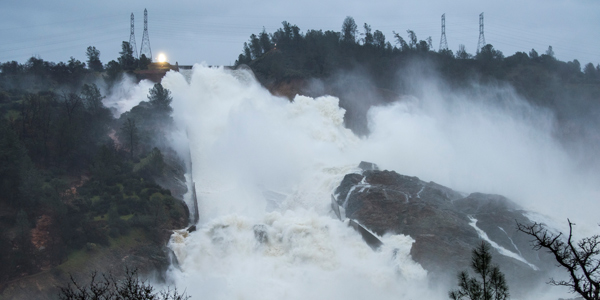By Robert Mullin
Water levels behind the FERC-regulated Oroville Dam have continued to decline in recent days, falling to nearly 50 feet below the height of a severely damaged emergency spillway, according to the California Department of Water Resources (CDWR), the dam’s operator.
On Feb. 12, local officials ordered the evacuation of about 188,000 residents after the erosion of a hillside beneath the dam’s emergency spillway threatened to flood areas near the Northern California town of Oroville, located about 75 miles north of Sacramento. CDWR was required to use that spillway for the first time since the dam’s completion nearly 50 years ago after heavy flows out of the reservoir tore a massive hole in the concrete lining of the main spillway.
Residents have since been allowed to return to their homes but face the potential for another evacuation if weather conditions once again destabilize the ground around the dam.
Criticism for FERC, California Agency
The spillway failure has generated criticism of both CDWR and FERC for their failure to heed previous warnings by three environmental groups who — during the dam’s 2005 FERC relicensing proceeding — requested that the state pave the hillside below the emergency spillway to avoid the kind of erosion experienced earlier this month.
CDWR and the commission rejected the request, with a FERC engineer writing that the emergency spillway could safely handle 350,000 cubic feet of water per second (cfs). The flow was only 6,000 to 12,000 cfs when the spillway was damaged, according to a report from the Bay Area News Group.
Outflows are outpacing flows into the reservoir despite stormy conditions, and CDWR said it will continue to prioritize bringing the depth of the reservoir to a target level of 895 feet. The agency said Feb. 20 that it had increased outflows from 55,000 cfs to 60,000 cfs in anticipation of increased inflows from recent rains.
“As runoff flows into the reservoir, water levels will likely fluctuate but will remain within acceptable and typical depths during times of storm activity,” the agency said in a Feb. 19 incident update.
CDWR said work crews continued to place rock and cement slurry into the areas affected by erosion, as ordered by FERC in a letter Feb. 13. In addition to ordering emergency repairs, FERC also ordered the state to convene an independent board of consultants to review current conditions and risk-reduction measures and to later conduct a forensic analysis to determine the cause of the failure.
“We have people there 24/7 from our San Francisco office as well as our Washington, D.C., office working with state officials … to protect public safety,” acting Chairman Cheryl LaFleur said in remarks at the winter meeting of the National Association of Regulatory Utility Commissioners on Feb. 14.
Rainy Winter
After years of drought, the region has experienced unusually high levels of precipitation this winter, which has filled the reservoir to capacity and left the lake’s elevation at about 900 feet above sea level. Snowpack in the Sierra Nevada mountains currently stands at about 175% of normal ahead of the spring melt, which tends to peak at the beginning of April, sending additional flows into the lake.
The 770-foot-high Oroville Dam in Butte County is the tallest in the U.S. and impounds one of California’s largest manmade lakes, a key source of water for farms in the state’s Central Valley and residents in Southern California, hundreds of miles to the south.
The dam’s Edward Hyatt and Thermalito generating facilities, which have a combined 933 MW capacity, remain offline, and three 230-kV transmission line segments in the area under CAISO control have been de-energized. The ISO said it had reoptimized its dispatch system to maintain reliability while continuing to meet demand within its balancing authority area.
“The loss of the Edward Hyatt power plant at Oroville dam is handled as we do with all generator outages,” the ISO told RTO Insider. “The outage, as well as the line outages, do not threaten grid reliability.”
County Seeks FERC Help
Officials from Butte County last week urged FERC to order CDWR to immediately establish its own public safety program to relieve the county of the “severe strain” on its “limited resources” (P-2100).
The county asked that the CDWR be ordered to provide law enforcement and other personnel needed to ensure public safety in the face of threats attributable to the dam, “including not just flood hazards but also fire, crime and other emergency services.”
Those personnel “should have the capacity to organize and implement all necessary public safety measures to prevent death from a failure of the dam spillways, including the orderly evacuation of the hundreds of thousands of people from the area downstream of the dam,” the county said in its Feb. 15 filing.
The filing also called out FERC for its failure to address Butte County’s previous entreaties, including a 2009 complaint in which the county argued that CDWR was in violation of its federal license for not contributing to covering the costs of ensuring adequate public safety at the Oroville site.
The commission rebuffed that complaint, and later denied the county a rehearing, after determining that the dam was in good condition and that the county had not pointed to any direct license violations.
“Because the commission has refused to order DWR to do what DWR is legally and morally obligated to do, and what other similarly situated licensees have done, Butte County has no choice but to request the commission to exercise its authority … to order DWR to take actions to effect its obligations as a Federal Power Act licensee, to protect public health, safety and welfare,” the county said.



